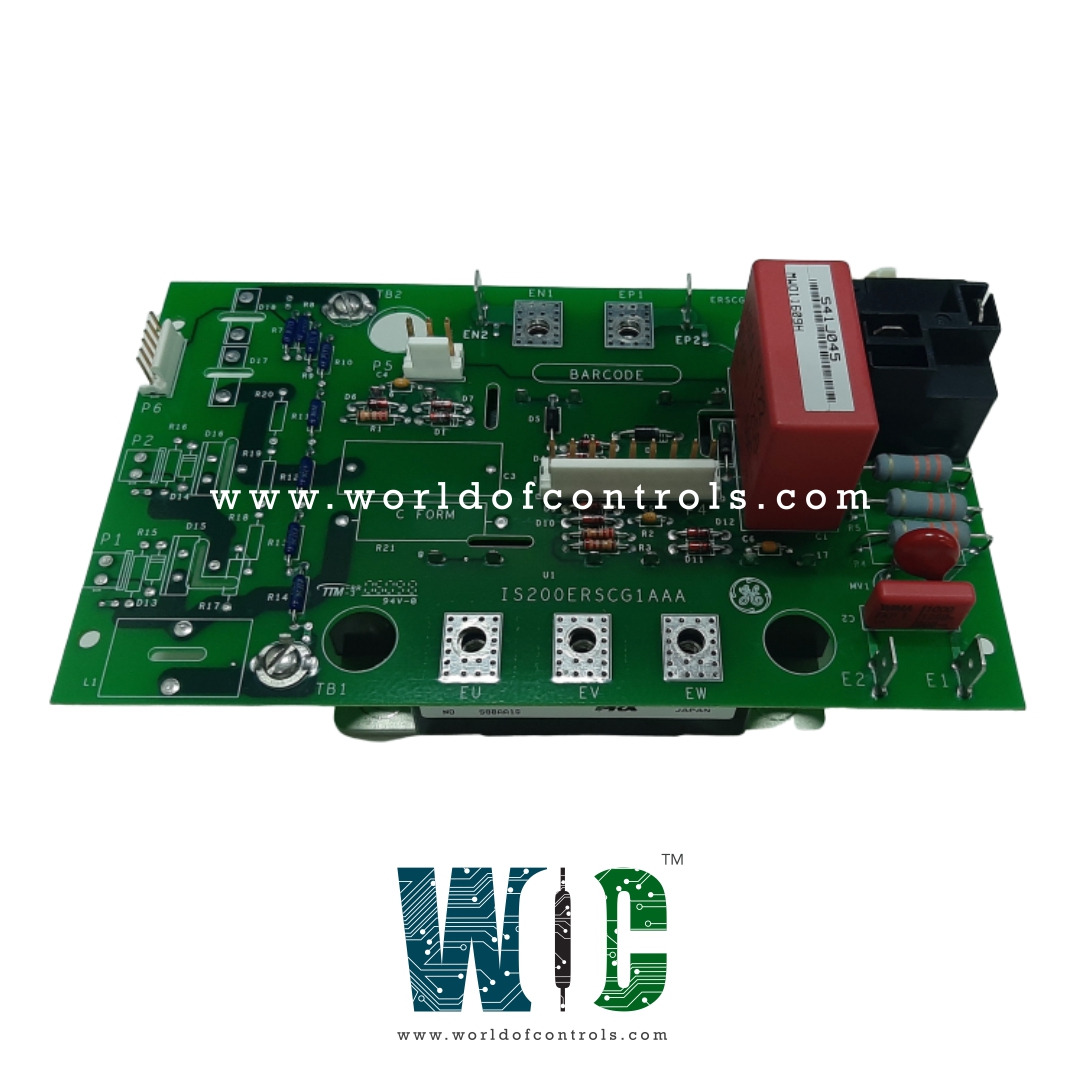SPECIFICATIONS
Part Number: IS200ERSCG1A
Manufacturer: General Electric
Series: EX2100
Function: Exciter Regulator Static Converter
Availability: In Stock
Country of Manufacture: United States (USA)
Functional Description
IS200ERSCG1A is an EX2100 Exciter Regulator Static Converter (ERBP) designed by General Electric. It is a part of the EX2100 series used in the Excitation control systems. It interfaces with the direct current (dc) source and the field, establishing connections with the Exciter Regulator Redundant Relay (ERRR) board and the Exciter Regulator Dynamic Discharge (ERDD) board. It facilitates interconnection for dc/dc static power conversion functions and field discharge operations. ERSCG1 is designed for simplex applications exclusively.
Features
- Input Power and Output Capacity: The input power sources include rectified alternating current (ac), direct current from a station battery, or a combination of both. The board delivers a maximum output of 250 volts direct current (V dc) at 35 amperes (A dc) continuously. Additionally, it can provide 250 V dc at 52.5 A dc for a duration of 10 seconds.
- Functionality Modes: The board offers functionality to operate in either a simplex system or a redundant system, where two complete regulator systems are linked to a single field.
- Power Switching Mechanism: The board utilizes an insulated gate bipolar transistor (IGBT) module mounted on the board for most static power switching operations. However, field discharge for redundant switchover is an exception.
A relay, denoted as K3, is incorporated to bypass the dc link charging resistor for specific functionalities.
- ERSCG2 Additional Pathway: ERSCG2 features a distinct pathway designed for latched field discharge during the transition from the primary to the redundant regulator. This functionality aids in ensuring a smooth switchover process. The board's functionality, adaptable configurations, power handling capabilities, and specialized pathways contribute significantly to the efficient and reliable operation of EX2100 regulator control systems, especially in managing static power conversion and field discharge operations.
Application Data
- Physical Dimensions: The module measures approximately 4 inches in width and 6 inches in height, presenting a compact form factor suitable for integration within the EX2100 regulator control system.
- IGBT Module Attachment: The board houses an insulated gate bipolar transistor (IGBT) module, connected to the ERSC using twelve soldered gate lead connections and four bolted power connections. This configuration ensures a secure and reliable connection between the IGBT module and the board.
The IGBT module is mounted vertically on a dedicated heat sink using four mounting screws. This setup enhances heat dissipation and aids in maintaining optimal operating temperatures for efficient performance.
- Interface Connections: The board serves as an interface linking connections between the dc source and the field, establishing crucial communication and interaction with the ERRR (Exciter Regulator Redundant Relay) and ERDD (Exciter Regulator Dynamic Discharge) boards. These connections enable seamless integration and coordination between various components within the control system.
Voltage Sensing
- Voltage Attenuator Function: The primary function of the voltage attenuator is to gauge and regulate the voltage supplied to the field within the system.
- Connection Points: The positive input of this voltage attenuator is directly linked to the positive terminal of the field. Importantly, this positive terminal shares a conductive pathway with the redundant discharge circuit, ensuring a synchronized operation within the system. Conversely, the negative input of the voltage attenuator is interconnected to the line side of the current shunt, establishing a reference point for differential voltage measurement.
- Differential Voltage Feedback: As a result of the voltage attenuation process, a differential voltage feedback signal is generated. This feedback signal, modulated by the attenuator resistor, conveys essential information about the voltage output directed towards the field. This differential voltage feedback signal, once processed, is then transmitted back to the Exciter Regulator Dynamic Discharge board. It serves as a means of relaying critical voltage information, enabling the ERDD board to monitor and regulate the voltage levels directed to the field.
WOC supports a large number of GE Speedtronic Replacement Parts. Please do not hesitate to contact us if you require additional information or have a question.
�
FREQUENTLY ASKED QUESTIONS
�
What is GE EX2100 IS200ERSCG1A?
It is a General Electric EX2100 Exciter Regulator Static Converter from the Mark VI series used in excitation control systems.
What Power Inputs and Outputs Does the ERSC Support?
It�accepts input power in the form of rectified alternating current (ac), direct current from a station battery, or a combination of both. Its maximum output capacity is 250 volts direct current (V dc) at 35 amperes (A dc) continuously. Additionally, it can deliver 250 V dc at 52.5 A dc for a duration of 10 seconds.
Can the board operate in both simplex and redundant systems?
Yes, the board offers functionality to operate in either a simplex system or a redundant system. It supports the connection of two complete regulator systems to a single field in redundant setups.
How are static power switching operations managed?
The board predominantly manages static power switching through a board-mounted insulated gate bipolar transistor (IGBT) module. However, during redundant switchover for field discharge, a relay labeled as K3 bypasses the dc link charging resistor.
